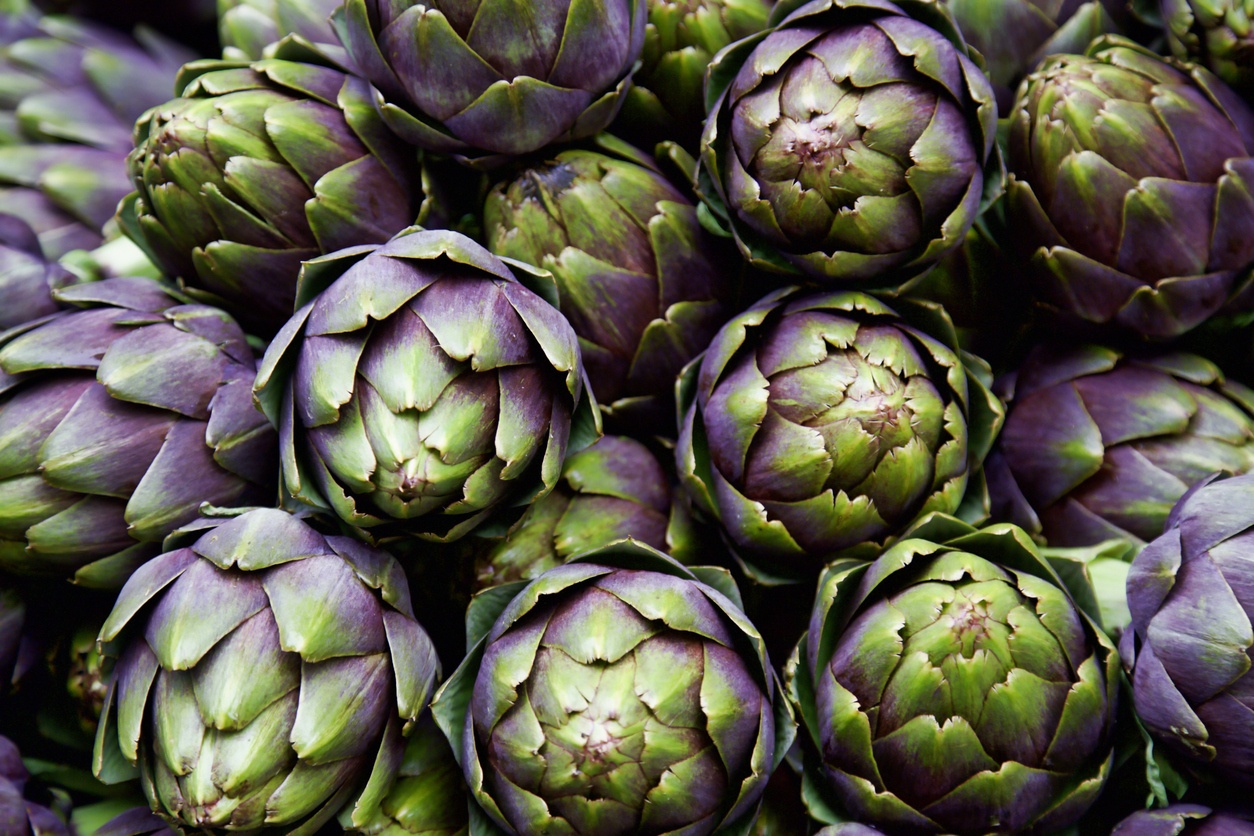Note: Quoted prices valid through April 9, 2024 at all four Sonoma County Oliver’s Market locations.
Artichokes are one of those vegetables that are often considered luxurious or complicated, not because they’re particularly difficult to find or grow, but because they’re so much work to prepare! For the uninitiated, even if you figure out how to cook them, there’s the question of which parts you actually eat, how to get the meat off the leaves, and what you can serve them with. In reality, the challenge seems to lie in the lack of knowledge about preparing artichokes rather than the actual preparation itself. With a little reading and some elbow grease, anyone can prepare gorgeous, fresh artichokes to great success!
But first, some background: Artichokes are actually large members of the thistle family, and the portion of the plant that is eaten is in fact a flower bud that has yet to bloom. These floral delights have roots going as far back as the ancient Greeks and beyond – the Greeks even had a whole mythos surrounding the creation of the artichoke! Over the years, they eventually made their way to Northern Europe as well as the Americas, and a number of different varieties or artichokes began to crop up around the world; that being said, globe artichokes are still considered “true” artichokes and are one of the best varieties for a quality artichoke experience.
Though artichokes are definitely deserving of their reputation as delicacies, these little beauties should also be known for their outstanding nutritional value. According to the USDA, artichokes contain the highest levels of antioxidants of any known vegetable, and these antioxidants include compounds that have been proven to help with liver health, heart health, and even cancer prevention. Additionally, they have an exceptionally high ratio of fiber – one medium sized artichoke can contain over 6 grams of fiber. That’s nearly a quarter of the suggested daily fiber intake for an adult, and at a very reasonable 60 calories a pop too! Artichokes also contain all manner of vitamins and minerals, including Vitamin C, Vitamin K, Phosphorus, Potassium, Folate, and Folic Acid, as well as other compounds vital to maintaining healthy organ function.
While artichokes certainly have enough health benefits to merit consideration for Superfood status, their rather ‘prickly’ reputation tends to keep people from attempting to prepare them, and marinated artichoke hearts seem to wind up mixed with mayonnaise and cheese more often than not. So, how do we get past our collective intimidation by fresh artichokes and start reaping the health and flavor benefits? Knowledge is key: Let’s prep an artichoke for cooking!
Artichoke Prep
Getting an artichoke ready to cook is viewed by many as the most challenging part of the process. In fact, it’s actually very easy – no fancy knife skills required!
First, you’ll need to assemble some kitchen tools. These include a serrated knife, a paring knife or vegetable peeler, a pair of kitchen shears, plus a large bowl of water mixed with lemon juice. The water will prevent your prepared artichokes from oxidizing, keeping them green and fresh. Along with your artichokes, you’ll also want a few slices of lemon, as these will be used to rub down the freshly cut artichokes. Once you have the necessary items assembled, it’s time to start prepping!
Minding any spines on the leaf tips, use the serrated knife to trim off the top inch of the artichoke as well as the bottom of the stem. The stem itself is actually completely edible, so chop off just enough to remove the less-than-fresh stem’s end. Next, pull off and discard the dry, older leaves at the base of the artichoke. This usually requires you to remove about two layers of leaves. Once that is done, use the kitchen shears to trim the tops of the leaves by about a quarter of an inch, or whatever length is necessary to remove the spines. If you’re working with younger artichokes, this step may not be necessary, but it’s a must for more mature artichokes. Finally, using the paring knife or vegetable peeler, carefully peel the woody outer layer of the stem to reveal the tender interior. Rub any freshly cut areas down with your lemon to prevent them oxidizing, and place in the lemon water until cooking.
If you’re planning on stuffing or roasting your artichokes, you’ll also want to remove the choke, or the purple fuzzy part at the center of the artichoke. The choke is safe to eat but is considered inedible, due to its texture. Simply pull the leaves apart slightly and scrape at the choke with a small spoon until you’ve removed it completely, being careful not to scrape away any of the delicious heart.
Maximum Artichoke Enjoyment
Once you have your artichokes prepped and ready, there’s really no limit to the kinds of dishes you can make. Here are a few of our personal favorites:
Steamed
Fill a medium pot with a few inches of water, and drop in a sliced lemon, four or five cloves of garlic, and three sprigs of rosemary. When the water boils, place your trimmed artichokes top down in the steamer basket and place them in the pot; let the artichokes steam for about 25 to 30 minutes, or until they are cooked through. An easy way to test for doneness is to pull off a leaf – if the leaf comes off without any resistance, you know the artichoke is ready to eat! Steamed artichokes are great with a little melted butter to dunk in or even aioli, but steaming artichokes can also be the first step in creating something even more fabulous.
Grilled
A great way to jazz up a steamed artichoke with minimal effort is by throwing them on the grill! While your artichokes are steaming, start heating a grill or grill pan; artichokes are notorious for oxidizing even after they’ve been cooked, so cutting out any sort of downtime will help you keep them looking pristine. Slice the freshly steamed artichokes in half lengthwise and remove the choke, then toss the artichokes with salt, pepper, and olive oil until the artichokes are evenly coated. Place the artichokes on the very hot grill or grill pan cut side down, and grill until evenly charred on both sides, about one to two minutes. Grilled artichokes are great on their own, or serve them as part of a salad or as a side dish with grilled meats.
Roasted
Roasted artichokes are one of the few preparations where you start with the artichokes completely fresh. Start by preparing the seasoning: roughly chop about 6 cloves of garlic and about 2 tablespoons of fresh rosemary, then cut a lemon into eighths. Trim up your artichokes as you would normally, removing the stems, then spread the leaves slightly and scrape out the choke. Into this space, place about a half teaspoon of garlic, a sprinkling of rosemary, and one of the lemon pieces; drizzle the artichoke with olive oil and season with salt and pepper. Bake at 400 degrees uncovered for about fifteen minutes, then cover the artichokes with aluminum foil and allow them to continue baking for about 20 minutes or until a leaf pulls out easily.
Recipes
Check out our website for some delicious sauces for dipping your artichoke leaves in, including Lemon Garlic Aioli and Creamy Ginger Soy Dip, or as an ingredient in Asparagus and Artichoke Pasta Salad with Pine Nuts and Arugula, an Artichoke Frittata, or Sauvignon Blanc Artichokes.
We hope that this information inspires you to try preparing Globe artichokes or do something new with them if you are already a fan. Underneath those thorny outer leaves, Globe artichokes are delicious, versatile, and healthy to boot. Get them before their season ends at great pricing this week at Oliver’s Market!


No comments yet. Add the first comment